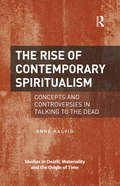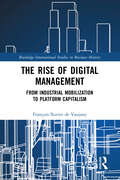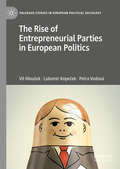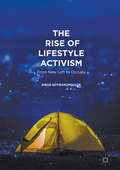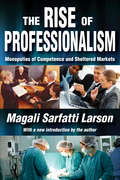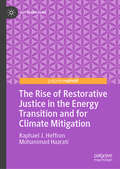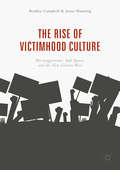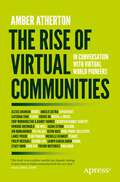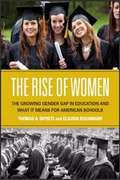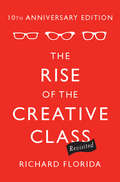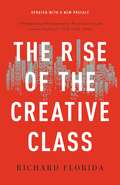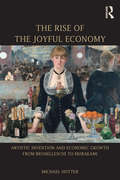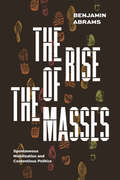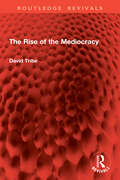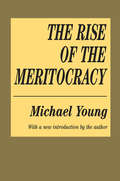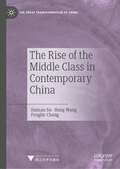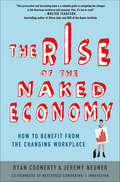- Table View
- List View
The Rise of Contemporary Spiritualism: Concepts and controversies in talking to the dead (Studies in Death, Materiality and the Origin of Time)
by Anne KalvigTalking to the dead and communication with 'the other side' is often presented as a taboo in an increasingly technological and medically advanced world. However, practices of spiritualism and mediumship continue to remain popular and in high demand within contemporary Western societies. This book analyses the practices of today’s mediums, who insist on standing at the threshold between life and death, interpreting signs and passing on communications, and asks how such concepts and practices are perceived by contemporary society. Using first-hand material gathered from alternative fairs, mediumistic congresses, séances, and interviews with both practitioners and clients, as well as thorough textual analysis, Anne Kalvig provides a clear overview of the various forms of consumption of mediumship in Western society and places these within a socio-cultural, religious and historical context. She also raises questions as to the controversies surrounding spiritualism and its representation and relationship with popular culture and the media. This book will be of interest to researchers in the field of sociology, religious studies, folklore, media studies and anthropology as well as to anyone interested in the upsurge of contemporary spiritualism, psychic phenomena and the paranormal.
The Rise of Critical Animal Studies: From the Margins to the Centre (Routledge Advances in Sociology)
by Nik Taylor Richard TwineAs the scholarly and interdisciplinary study of human/animal relations becomes crucial to the urgent questions of our time, notably in relation to environmental crisis, this collection explores the inner tensions within the relatively new and broad field of animal studies. This provides a platform for the latest critical thinking on the condition and experience of animals. The volume is structured around four sections: engaging theory doing critical animal studies critical animal studies and anti-capitalism contesting the human, liberating the animal: veganism and activism. The Rise of Critical Animal Studies demonstrates the centrality of the contribution of critical animal studies to vitally important contemporary debates and considers future directions for the field. This edited collection will be useful for students and scholars of sociology, gender studies, psychology, geography, and social work.
The Rise of Digital Management: From Industrial Mobilization to Platform Capitalism (Routledge International Studies in Business History)
by François-Xavier de VaujanyThis book analyzes the history of management, placing it in perspective with both American history and the genealogy of digital technology. Focusing on the years of industrial mobilization in the United States (from 1937 to 1945) and their extension into the Cold War, it shows particularly how "scientific management" was reconfigured and re-legitimized in favor of a new profoundly American geopolitics. In a context where the future was at a standstill, this research also explains what became of the managerial processes at the heart of capitalism from the 40s onwards: the shift from a managerial capitalism of calculation to a narrative capitalism made up of "desiring machines". This digital management no longer simply contributes, along with others, to unveiling and revealing the future. Aligned with the American obsession with novelty, it is the very process of revelation and unveiling, with managers and consumers alike becoming the intersecting subjects of desires borne of managerial apocalypses.To explore this period of American history, the author has combined a triple narrative anchored in three types of archives: an intimate history of this reconfiguration from the presence in New York of Saint-Exupéry, Burnham and Wiener; a description of the great historical moment of industrial mobilization; and a philosophical speculation about reconfiguration and its links to American history.
The Rise of Entrepreneurial Parties in European Politics (Palgrave Studies in European Political Sociology)
by Vít Hloušek Lubomír Kopeček Petra VodováPolitical parties run by entrepreneurs as a means to their own end are a recent phenomenon found in many countries, and their electoral influence has never been greater. This book offers a thorough comparative analysis of such ‘business-firm’ and sometimes oddly memberless parties in Western and East-Central Europe, assessing the considerable corpus of literature on the growing band of political entrepreneurs. The book clearly separates such party enterprises from other, more traditional, political platforms as it contributes to our understanding of the potential of entrepreneurial parties. The authors offer a unique typology based on two characteristics: whether the party receives private financial, media or other investment; and the nature of its membership and territorial structure. Famous examples of entrepreneurial parties, including Silvio Berlusconi’s Forza Italia and Geert Wilders’s Party for Freedom, alongside their lesser-known counterparts, serve in this book as valuable material for conceptual innovation and the investigation into why certain entrepreneurial party types succeed or fail.
The Rise of Lifestyle Activism: From New Left to Occupy
by Nikos SotirakopoulosThis book explores changes in the values and ideas of a large part of the political Left in recent decades. The author identifies that a questioning of the merits of economic growth; an ideal of environmental sustainability overriding the old radical visions of material abundance; a critique of instrumental reason; a suspiciousness towards universalist claims; and an attachment to subjective and pluralistic identities, have been dominant in the narratives of the Leftist milieu and of social movements. Yet the author suggests that such changes, known as ‘lifestyle activism’, could be understood in a different way, one characterised by suspiciousness towards the belief that human action guided by reason can lead society towards a future that will be better and more affluent. Using a range of case studies from the 1960's to the present day anti-austerity movement, Sotirakopoulos argues that the New Left and its ideological heirs could be understood not so much as a continuation, but as an inversion from the Old Left and, most importantly, from humanistic visions of modernity. The book will therefore be ideal reading for students and researchers of political sociology, radical politics, modern political ideologies, contentious politics and political theory and to scholars of new social movements and the New Left.
The Rise of Politically Motivated Cyber Attacks: Actors, Attacks and Cybersecurity (Routledge Studies in Crime and Society)
by Tine MunkThis book outlines the complexity in understanding different forms of cyber attacks, the actors involved, and their motivations. It explores the key challenges in investigating and prosecuting politically motivated cyber attacks, the lack of consistency within regulatory frameworks, and the grey zone that this creates, for cybercriminals to operate within. Connecting diverse literatures on cyberwarfare, cyberterrorism, and cyberprotests, and categorising the different actors involved – state-sponsored/supported groups, hacktivists, online protestors – this book compares the means and methods used in attacks, the various attackers, and the current strategies employed by cybersecurity agencies. It examines the current legislative framework and proposes ways in which it could be reconstructed, moving beyond the traditional and fragmented definitions used to manage offline violence. This book is an important contribution to the study of cyber attacks within the areas of criminology, criminal justice, law, and policy. It is a compelling reading for all those engaged in cybercrime, cybersecurity, and digital forensics.
The Rise of Professionalism: Monopolies of Competence and Sheltered Markets
by Vilfredo ParetoWhat gave rise to our modern conceptions of professional status, and how did particular professions gain their privileged status? Magali Sarfatti Larson shows how our present conception and acceptance of profession was shaped in the liberal phase of capitalism.Larson argues that professionalization was both a response to the extension of market relations and a movement for the conquest of collective social status by sectors of the bourgeoisie. By comparing the development of various professions in England and the United States during the first part of the nineteenth century, the author gives concrete historical illustration to the multiple relations professions form within their society.Larson examines the new conditions of professionalization in the phase of corporate capitalism, drawing on a number of historical and sociological sources. While professions began as a mode of autonomous work organization, many credentialed occupations aspire to professionalize in order to shelter the labor markets in which they work. Larson argues that the idea of profession can function as a form of ideological control and concludes that today professionalism works against many of the values that had been historically vested in it. This classic book, complete with a new introduction that brings the work into the twenty-first century, is timely and should be read by all interested in the history and development of organizational life.
The Rise of Restorative Justice in the Energy Transition and for Climate Mitigation (Just Transitions)
by Raphael J. Heffron Mohammad HazratiThe book presents the importance of restorative justice in today’s energy transition across the world. It emphasizes the importance of a fair, equitable and inclusive shift towards a low-carbon economy. It recognizes climate change as the primary global challenge and advocates for an urgent and comprehensive energy transition where restorative justice is centrally utilised. Restorative justice focuses on identifying harm, assigning responsibility, protecting those affected, repairing damage, preventing future occurrences and providing a crucial foundation for seeking justice. It encompasses various forms of harm (economic, environmental, and social) and includes all stakeholders, including individuals, communities, and the environment. By providing a secure and structured platform for dialogue, restorative justice allows for diverse perspectives, challenging conversations and action for a just and sustainable world.
The Rise of Viagra: How the Little Blue Pill Changed Sex in America
by Meika LoeThe first book to details the history and social implications of the little blue pillSince its introduction in 1998, Viagra has launched a new kind of sexual revolution. Quickly becoming one of the most sought after drugs in history, the little blue pill created a sea change within the pharmaceutical industry—from how drugs could be marketed to the types of drugs put into development—as well as the culture at large. Impotency is no longer an embarrassing male secret; now it is called “erectile dysfunction,” and is simply something to “ask your doctor” about. And over 16 million men have.The Rise of Viagra is the first book to detail the history and the vast social implications of the Viagra phenomenon. Meika Loe argues that Viagra has changed what qualifies as normal sex in America. In the quick-fix, pill-for-everything culture that Viagra helped to create, erections can now be had by popping a pill, making sex on demand, regardless of age or infirmity, and, potentially, for the rest of one's life.Drawing on interviews with men who take the drug, their wives, doctors and pharmacists as well as scientists and researchers in the field, this fascinating account provides an intimate history of the drug's effect on America. Loe also examines the quest for the female Viagra, the impact of the drug around the world, the introduction of new erection drugs, like Levitra and Cialis, and the rapid growth of the multi-billion dollar pharmaceutical industry.This wide-ranging book explains how this medical breakthrough and cultural phenomenon have forever changed the meaning of sex in America.
The Rise of Victimhood Culture: Microaggressions, Safe Spaces, and the New Culture Wars
by Bradley Campbell Jason ManningThe Rise of Victimhood Culture offers a framework for understanding recent moral conflicts at U.S. universities, which have bled into society at large. These are not the familiar clashes between liberals and conservatives or the religious and the secular: instead, they are clashes between a new moral culture—victimhood culture—and a more traditional culture of dignity. Even as students increasingly demand trigger warnings and “safe spaces,” many young people are quick to police the words and deeds of others, who in turn claim that political correctness has run amok. Interestingly, members of both camps often consider themselves victims of the other. In tracking the rise of victimhood culture, Bradley Campbell and Jason Manning help to decode an often dizzying cultural milieu, from campus riots over conservative speakers and debates around free speech to the election of Donald Trump.
The Rise of Virtual Communities: In Conversation with Virtual World Pioneers
by Amber AthertonUncover the fascinating history of virtual communities and how we connect to each other online. The Rise of Virtual Communities, explores the earliest online community platforms, mapping the technological evolutions, and the individuals, that have shaped the culture of the internet.Read in-depth interviews with the visionary founders of iconic online platforms, and uncover the history of virtual communities and how the industry has developed over time. Featuring never-before told stories, this exploration introduces new ideas and predictions for the future, explaining how we got here and challenging what we think we may know about building online communities.Readers will: Learn what a virtual community is and how it has become an integral part of modern society Review key insights into building virtual communities and platforms from the founders and pioneers who created them See what the current developments and the potential challenges are related to the future of virtual communitiesWho is this for:Community managers, company founders and those who want to know more about the origins and future of virtual communities.interviews Include:Randy Farmer & Chip Morningstar – Lucasfilm Games ‘Habitat’ and creators of the modern AvatarHoward Rheingold - Community expert and member of the WELLStacy Horn - Founder of Echo NYCJim Bumgardner - Founder of The PalacePhilip Rosedale - Founder of Second LifeSampo Karjalainen - Co-founder of Habbo HotelLance Priebe - Co-Founder of Club Penguin Angelo Sotira - Co-Founder of Deviant Art Caterina Fake - Co-Founder of FlickrAlexis Ohanian- Founder of Reddit Kevin Rose – Co-Founder of Digg & PROOF CollectiveJason Citron - Founder of Discord Trevor McFedries - Founder of FWB & Brud Cherie Hu - Founder of Water & MusicMichelle Kennedy - Founder of Peanut
The Rise of Women: The Growing Gender Gap in Education and What it Means for American Schools
by Claudia Buchmann Thomas A. DipreteWhile powerful gender inequalities remain in American society, women have made substantial gains and now largely surpass men in one crucial arena: education. Women now outperform men academically at all levels of school, and are more likely to obtain college degrees and enroll in graduate school. What accounts for this enormous reversal in the gender education gap? In The Rise of Women: The Growing Gender Gap in Education and What It Means for American Schools, Thomas DiPrete and Claudia Buchmann provide a detailed and accessible account of women’s educational advantage and suggest new strategies to improve schooling outcomes for both boys and girls. The Rise of Women opens with a masterful overview of the broader societal changes that accompanied the change in gender trends in higher education. The rise of egalitarian gender norms and a growing demand for college-educated workers allowed more women to enroll in colleges and universities nationwide. As this shift occurred, women quickly reversed the historical male advantage in education. By 2010, young women in their mid-twenties surpassed their male counterparts in earning college degrees by more than eight percentage points. The authors, however, reveal an important exception: While women have achieved parity in fields such as medicine and the law, they lag far behind men in engineering and physical science degrees. To explain these trends, The Rise of Women charts the performance of boys and girls over the course of their schooling. At each stage in the education process, they consider the gender-specific impact of factors such as families, schools, peers, race and class. Important differences emerge as early as kindergarten, where girls show higher levels of essential learning skills such as persistence and self-control. Girls also derive more intrinsic gratification from performing well on a day-to-day basis, a crucial advantage in the learning process. By contrast, boys must often navigate a conflict between their emerging masculine identity and a strong attachment to school. Families and peers play a crucial role at this juncture. The authors show the gender gap in educational attainment between children in the same families tends to be lower when the father is present and more highly educated. A strong academic climate, both among friends and at home, also tends to erode stereotypes that disconnect academic prowess and a healthy, masculine identity. Similarly, high schools with strong science curricula reduce the power of gender stereotypes concerning science and technology and encourage girls to major in scientific fields. As the value of a highly skilled workforce continues to grow, The Rise of Women argues that understanding the source and extent of the gender gap in higher education is essential to improving our schools and the economy. With its rigorous data and clear recommendations, this volume illuminates new ground for future education policies and research.
The Rise of the Chicago Police Department: Class and Conflict, 1850-1894
by Sam MitraniIn this book, Sam Mitrani cogently examines the making of the police department in Chicago, which by the late 1800s had grown into the most violent, turbulent city in America. Chicago was roiling with political and economic conflict, much of it rooted in class tensions, and the city's lawmakers and business elite fostered the growth of a professional municipal police force to protect capitalism, its assets, and their own positions in society. Together with city policymakers, the business elite united behind an ideology of order that would simultaneously justify the police force's existence and dictate its functions. Tracing the Chicago police department's growth through events such as the 1855 Lager Beer riot, the Civil War, the May Day strikes, the 1877 railroad workers strike and riot, and the Haymarket violence in 1886, Mitrani demonstrates that this ideology of order both succeeded and failed in its aims. Recasting late nineteenth-century Chicago in terms of the struggle over order, this insightful history uncovers the modern police department's role in reconciling democracy with industrial capitalism.
The Rise of the Creative Class--Revisited
by Richard FloridaThe Washington Monthly 2002 Annual Political Book Award WinnerThe Rise of the Creative Class gives us a provocative new way to think about why we live as we do today-and where we might be headed. Weaving storytelling with masses of new and updated research, Richard Florida traces the fundamental theme that runs through a host of seemingly unrelated changes in American society: the growing role of creativity in our economy. Just as William Whyte's 1956 classic The Organization Man showed how the organizational ethos of that age permeated every aspect of life, Florida describes a society in which the creative ethos is increasingly dominant. Millions of us are beginning to work and live much as creative types like artists and scientists always have-with the result that our values and tastes, our personal relationships, our choices of where to live, and even our sense and use of time are changing. Leading the shift are the nearly 38 million Americans in many diverse fields who create for a living-the Creative Class. The Rise of the Creative Class chronicles the ongoing sea of change in people's choices and attitudes, and shows not only what's happening but also how it stems from a fundamental economic change. The Creative Class now comprises more than thirty percent of the entire workforce. Their choices have already had a huge economic impact. In the future they will determine how the workplace is organized, what companies will prosper or go bankrupt, and even which cities will thrive or wither.
The Rise of the Creative Class--Revisited
by Richard FloridaThe Washington Monthly 2002 Annual Political Book Award WinnerThe Rise of the Creative Class gives us a provocative new way to think about why we live as we do today-and where we might be headed. Weaving storytelling with masses of new and updated research, Richard Florida traces the fundamental theme that runs through a host of seemingly unrelated changes in American society: the growing role of creativity in our economy.Just as William Whyte's 1956 classic The Organization Man showed how the organizational ethos of that age permeated every aspect of life, Florida describes a society in which the creative ethos is increasingly dominant. Millions of us are beginning to work and live much as creative types like artists and scientists always have-with the result that our values and tastes, our personal relationships, our choices of where to live, and even our sense and use of time are changing. Leading the shift are the nearly 38 million Americans in many diverse fields who create for a living-the Creative Class.The Rise of the Creative Class chronicles the ongoing sea of change in people's choices and attitudes, and shows not only what's happening but also how it stems from a fundamental economic change. The Creative Class now comprises more than thirty percent of the entire workforce. Their choices have already had a huge economic impact. In the future they will determine how the workplace is organized, what companies will prosper or go bankrupt, and even which cities will thrive or wither.
The Rise of the Creative Class--Revisited
by Richard FloridaThe Washington Monthly 2002 Annual Political Book Award WinnerThe Rise of the Creative Class gives us a provocative new way to think about why we live as we do today-and where we might be headed. Weaving storytelling with masses of new and updated research, Richard Florida traces the fundamental theme that runs through a host of seemingly unrelated changes in American society: the growing role of creativity in our economy. Just as William Whyte's 1956 classic The Organization Man showed how the organizational ethos of that age permeated every aspect of life, Florida describes a society in which the creative ethos is increasingly dominant. Millions of us are beginning to work and live much as creative types like artists and scientists always have-with the result that our values and tastes, our personal relationships, our choices of where to live, and even our sense and use of time are changing. Leading the shift are the nearly 38 million Americans in many diverse fields who create for a living-the Creative Class. The Rise of the Creative Class chronicles the ongoing sea of change in people's choices and attitudes, and shows not only what's happening but also how it stems from a fundamental economic change. The Creative Class now comprises more than thirty percent of the entire workforce. Their choices have already had a huge economic impact. In the future they will determine how the workplace is organized, what companies will prosper or go bankrupt, and even which cities will thrive or wither.
The Rise of the Creative Class: And How It's Transforming Work, Leisure, Community, And Everyday Life (Art Of Mentoring Ser.)
by Richard FloridaWorld-renowned urbanist Richard Florida's bestselling classic on the transformation of our cities in the twenty-first century -- now updated with a new prefaceIn his modern classic The Rise of the Creative Class, urbanist Richard Florida identifies the emergence of a new social class reshaping the twenty-first century's economy, geography, and workplace. This Creative Class is made up of engineers and managers, academics and musicians, researchers, designers, entrepreneurs and lawyers, poets and programmer, whose work turns on the creation of new forms. Increasingly, Florida observes, this Creative Class determines how workplaces are organized, which companies prosper or go bankrupt, and which cities thrive, stagnate or decline.Florida offers a detailed occupational, demographic, psychological, and economic profile of the Creative Class, examines its global impact, and explores the factors that shape "quality of place" in our changing cities and suburbs. Now updated with a new preface that considers the latest developments in our changing cities, The Rise of the Creative Class is the definitive edition of this foundational book on our contemporary economy.
The Rise of the Information Technology Society in India: Capitalism and the Construction of a Vulnerable Workforce (Dynamics of Virtual Work)
by Suddhabrata Deb RoyThis book is a study of workers in India’s Informational Technology sector, and focuses on how the past three decades of neoliberal economic reforms have impacted the efforts to organize the workers in the sector given the socio-political and economic setbacks encountered by the broader labour movement. In doing so, the book explores the role of privatization, changing gender relations inside and outside the workplace, new organizational forms created by IT workers to advance their interests, and the increasingly precarious nature of IT work. By exploring how the growth of the IT sector in India has amplified and reproduced discrimination against unskilled and marginalized elements of the labour force, the book shows the ways in which other social and political divisions create considerable barriers when it comes to the ability of IT workers to successfully collaborate with other sectors within the Indian labour movement The book will be of interest to students and researchers of sociology, labour studies, political economy and gender studies.
The Rise of the Joyful Economy: Artistic invention and economic growth from Brunelleschi to Murakami
by Michael HutterThis book argues for the increasing importance of the arts as a major resource in fuelling growth through the experiential dimension of today’s economy. As we move from the knowledge economy to a new stage called the joyful economy, consumers shift their spending from physical objects and technical know-how to experiences of joy and disappointment. This book investigates how artistic ideas are translated into successful commercial production, and how economic growth impacts artistic invention. It examines cases of successful innovation in the creative industries ranging from the Italian Renaissance to the present. The book suggests a framework where social players move in diverse worlds of value, which leads to a stream of controversies and manias that result in the establishment of new joy products. Studies include the effect of linear perspective, as pioneered by Filippo Brunelleschi, the discovery of taste as an argument for consumption, the serial production of Pop Art and the self-commercialization of contemporary works by artists like Takashi Murakami . This theoretical and empirical study brings together the fields of cultural economics, economic sociology, management studies and cultural history. In doing so, it offers a fascinating study of how creativity has shaped and fuelled commerce.
The Rise of the Masses: Spontaneous Mobilization and Contentious Politics
by Benjamin AbramsAn insightful examination of how intersecting individual motivations and social structures mobilize spontaneous mass protests. Between 15 and 26 million Americans participated in protests surrounding the murders of George Floyd, Ahmaud Arbery, Breonna Taylor, and others as part of the Black Lives Matter protests in 2020, which is only one of the most recent examples of an immense mobilization of citizens around a cause. In The Rise of the Masses, sociologist Benjamin Abrams addresses why and how people spontaneously protest, riot, and revolt en masse. While most uprisings of such a scale require tremendous resources and organizing, this book focuses on cases where people with no connection to organized movements take to the streets, largely of their own accord. Looking to the Arab Spring, Occupy Wall Street, and the Black Lives Uprising, as well as the historical case of the French Revolution, Abrams lays out a theory of how and why massive mobilizations arise without the large-scale planning that usually goes into staging protests. Analyzing a breadth of historical and regional cases that provide insight into mass collective behavior, Abrams draws on first-person interviews and archival sources to argue that people organically mobilize when a movement speaks to their pre-existing dispositions and when structural and social conditions make it easier to get involved—what Abrams terms affinity-convergence theory. Shedding a light on the drivers behind large spontaneous protests, The Rise of the Masses offers a significant theory that could help predict movements to come.
The Rise of the Masses: Spontaneous Mobilization and Contentious Politics
by Benjamin AbramsAn insightful examination of how intersecting individual motivations and social structures mobilize spontaneous mass protests. Between 15 and 26 million Americans participated in protests surrounding the murders of George Floyd, Ahmaud Arbery, Breonna Taylor, and others as part of the Black Lives Matter protests in 2020, which is only one of the most recent examples of an immense mobilization of citizens around a cause. In The Rise of the Masses, sociologist Benjamin Abrams addresses why and how people spontaneously protest, riot, and revolt en masse. While most uprisings of such a scale require tremendous resources and organizing, this book focuses on cases where people with no connection to organized movements take to the streets, largely of their own accord. Looking to the Arab Spring, Occupy Wall Street, and the Black Lives Uprising, as well as the historical case of the French Revolution, Abrams lays out a theory of how and why massive mobilizations arise without the large-scale planning that usually goes into staging protests. ? Analyzing a breadth of historical and regional cases that provide insight into mass collective behavior, Abrams draws on first-person interviews and archival sources to argue that people organically mobilize when a movement speaks to their pre-existing dispositions and when structural and social conditions make it easier to get involved—what Abrams terms affinity-convergence theory. Shedding a light on the drivers behind large spontaneous protests, The Rise of the Masses offers a significant theory that could help predict movements to come.
The Rise of the Mediocracy (Routledge Revivals)
by David TribeFirst published in 1975, The Rise of the Mediocracy is exhaustive, disturbing, devastating, yet often very funny. It explodes the myth of meritocracy and the pretence of improved living standards. While the doom- boomers blame all our ills on trigger happy politicians, Arab oil sheikhs or polluting multinational corporations, the intractable problems of the world have come about through a multiplication of individual attitudes and actions whose end result is industrial anarchy, civil disorders, population explosion and declining standards.Many of the ‘good things’ of life- democracy, education, sociology, communications, growth, the welfare state- have contributed to the overall neurosis, trivialization and greed. As these good things will not likely be abandoned, the problems of contemporary society may well be insoluble. But if there are solutions they are unlikely to be implemented because everywhere there is an elitism not of meritocracy but of mediocracy, whose rise can be traced from the 18th century and has accelerated in recent years. No other book relates the discrediting of religion and politics, business and professions so plausibly to chaos in the arts, diminishing returns in education and curbless crime in society. This interdisciplinary book is an interesting read for students of humanities and social sciences.
The Rise of the Meritocracy (Pelican Ser.)
by Michael YoungMichael Young has christened the oligarchy of the future Meritocracy. Indeed, the word is now part of the English language. It would appear that the formula: IQ+Effort=Merit may well constitute the basic belief of the ruling class in the twenty-first century. Projecting himself into the year 2034, the author of this sociological satire shows how present decisions and practices may remold our society.It is widespread knowledge that it is insufficient to be somebody's nephew to obtain a responsible post in business, government, teaching, or science. Experts in education and selection apply scientific principles to sift out the leaders of tomorrow. You need intelligence rating, qualification, experience, application, and a certain caliber to achieve status. In a word, one must show merit to advance in the new society of tomorrow.In a new opening essay, Young reflects on the reception of his work, and its production, in a candid and lively way. Many of the critical ambiguities surrounding its original publication are now clarified and resolved. What we have is what the Guardian of London called A brilliant essay. and what Time and Tide described as a fountain gush of new ideas. Its wit and style make it compulsively enjoyable reading from cover to cover.
The Rise of the Middle Class in Contemporary China (The Great Transformation of China)
by Hong Wang Hainan Su Fenglin ChangThis book portrays the middle class in contemporary China with plain language and precise professional knowledge in an all-round, broad and responsible way from the perspectives of income, property, profession, education, consumption, investment, physiological and behavioral characteristics, history and development. It gives, in a logical order, the reasons for stimulating the rise of the middle class in contemporary China. It emphatically describes what the middle class is and what the middle class in contemporary China looks like. It also analyzes whether the middle class can rise in China and sheds light on the basic thinking, medium and long-term goals, main measures and current work priorities for achieving full rise of the middle class in contemporary China. As China becomes the world's largest economy, the new middle class will be the Chinese people facing the world; as such, this book will be of interest to sociologists, sinologists, political scientists, and economists.
The Rise of the Naked Economy: How to Benefit from the Changing Workplace
by Ryan Coonerty Jeremy NeunerWhat happens when work is no longer a place but a state of mind: when the trappings that have defined the economy as we knew it are stripped away and we start from the bare essence of what it means to make a living? From corner coffee shops to Fortune 500 companies, workers from all different backgrounds are creating a new reality and prosperity. The Rise of the Naked Economy shows readers how to achieve both personal and professional success in an economy that does not guarantee lifetime employment. Pioneers Coonerty and Neuner report from the front lines on the future of work. From the recently graduated to the recently laid off, this book covers how the rise in non-traditional employment calls for a new infrastructure, strategy, and attitude for workers, companies, and communities alike. Through interviews with the people, companies, and policymakers who are leading the change and already profiting from it, The Rise of the Naked Economy provides an optimistic, humorous, and inspirational vision for readers who want reclaim their lives and livelihoods.
